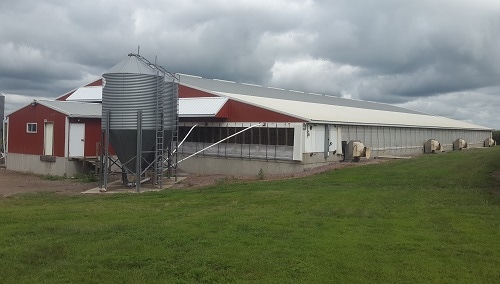Fresh air intakes can help reduce corrosion above soffits in swine buildings.
June 1, 2021

Providing a good environment in the production room is critical for the overall swine herd health. Air distribution in the production room is important, and this starts with fresh air intake into the building attic. Air generally will flow into the building attic to supply fresh air to the production room through the room ceiling air inlets. A typical design brings air into the attic through soffit intakes at the eave. However, this design can negatively impact the building by contributing to corrosion and deterioration of roof metal.
Air intakes at the soffit, while providing an unrestricted opening to the attic, can promote corrosion of building components due to pit gases entering the attic at the soffit intakes. During minimum ventilation, pit fans operate at reduced capacity and exhaust air with minimal speed. Often, this moist air discharging from the fans can remain near the building due to this low speed. This exhaust air can easily be drawn into nearby soffit intakes. Exhaust air, containing pit gases as well as moisture, can cause condensation on the bottom of roof panels and truss gusset plates causing them to corrode. The combination of moisture and hydrogen sulfide accelerates normal corrosion. This results in corroded roof panels forcing producers to prematurely replace them. The new roof panels will have the same short life span unless the fresh air intake into the attic is moved away from the pit fans.
An alternative exists to provide attic air intakes on the gable ends of the building (see photograph). In this design, the relative location of gable end intakes is farther from the pit fans in comparison to soffit intakes, thereby reducing the risk of moist exhaust air from the pit fans short circuiting back into the attic. This option allows the attic air intakes at the building eaves to be completely closed to avoid corrosion from pit fans. Thus, the ventilation system can bring in the cleanest possible air into the building attic. Closure of soffit intakes can help reduce or eliminate roof steel corrosion.
Placing fresh air intakes on the gable end of the swine building will require some remodeling of existing buildings. When doing this remodel, the gable end attic intake area should be sized so that airflow to the ceiling inlets is not limited. Field Agricultural Engineers at Iowa State University Extension and Outreach have developed a freely available publication that describes two different methods to size these gable end fresh air intakes. In the case of new construction, the soffit intakes should be eliminated or should not be vented, if included. In preexisting construction, soffit intakes should be closed off once the intakes are placed on the gable end(s) of the building. Sealing off the eave opening and making sure there is adequate insulation in the attic in any areas with inadequate insulation ensures that cold spots are avoided thus eliminating subsequent condensation.
The proper design of attic intakes, which allows air to flow freely to supply fresh air to the ceiling inlets, is important for the effective and efficient operation of a good ventilation system. Proper design, accompanied with proper insulation covering, can make swine building steel and truss plates last longer, thereby extending the life of the building and protecting the investment.
As a part of the Swine Building Maintenance Education Effort, the field agricultural engineers have developed a series of publications on concrete inspection, enhancing longevity and functioning of swine building components, maintenance and troubleshooting tools, and maintenance of wood trusses. These publications are available freely online through Extension Distribution Store at Iowa State University Extension and Outreach.
To further help with educating stakeholders on these topics in Summer 2021, four workshops have been scheduled in Central Iowa in collaboration with Iowa Department of Natural Resources. These workshops in Iowa will be held August 17 – Le Mars, August 18 – Webster City, August 19 – Nashua, and August 20 – Washington. Interested participants can register by calling their local county extension office in Iowa or can contact the author at 515-291-0174 or [email protected].
Source: Kapil Arora, Iowa State University, which is solely responsible for the information provided, and wholly owns the information. Informa Business Media and all its subsidiaries are not responsible for any of the content contained in this information asset.
You May Also Like



